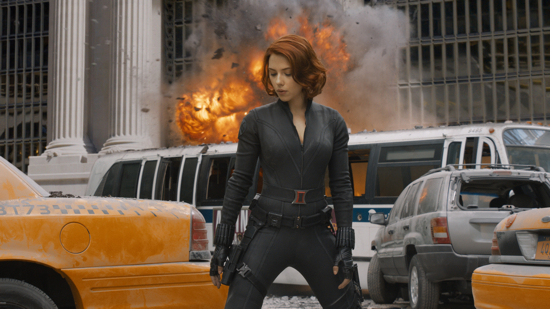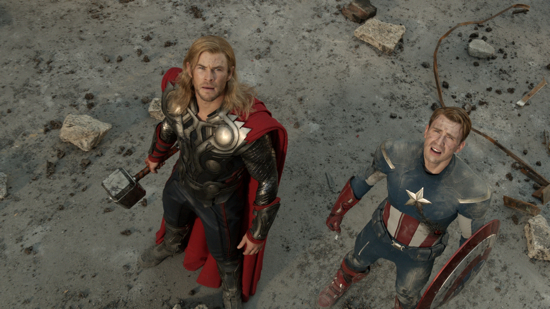Joss Whedon’s $220 million foray into the Marvel Universe begins speedily. We’re introduced to Loki (Tom Hiddleston), the prankster god of Asgard and brother to Thor (Chris Hemsworth), who plans to open a dimensional portal to the marauding Chitauri, a race of space aliens bent on enslaving humanity. Samuel L Jackson’s Nick Fury, head of military defence wing SHIELD, strides through a NASA installation towards the Tesseract, a mysterious and volatile energy source which explodes like an intergalactic cat flap allowing Loki to arrive on earth. Bullets are dodged and scientists are brainwashed by means of Loki’s sceptre, he escaping before the Tesseract explodes. The first 15 minutes establish a showdown between good and evil with a shoot-out, a car chase, and the total destruction of an American scientific facility. Fury rolls from the wreckage of a helicopter with one realisation: this means war.
It’s thrilling and ridiculously entertaining. Fury appoints top agent Natasha Romanoff (Scarlett Johansson as the Black Widow) to bring Dr Bruce Banner (Mark Ruffalo) back from humanitarian work in the slums of India. Clark Gregg reprises his role as Agent Phil Coulson, a recurring character from previous Marvel adaptations, dispatched to enlist Iron Man (a scene-stealing Robert Downey Jr) from New York. Fury seeks out Captain America (Chris Evans, biceps like balloons) in a bid to revive the Avengers initiative, which has until now been vetoed and frozen by Fury’s superiors in the military council.
Luckily things don’t get too swashbuckling too quickly. In the realm of comic book adaptations, straying too far from the source material usually means disaster. Whedon remains true to the Avengers’ beginnings, including friction, dysfunction and intramural suspicion. Loki wreaks merry chaos at a high society ball in Stuttgart before expounding his despotic philosophy, that freedom is life’s great lie and humans were made to be ruled. Hiddleston strikes a balance between mischief and malevolence, Loki’s wide-eyed hubris coming across like Richard E Grant’s Withnail played by an excitable and evil Jared Leto. There’s little time to ponder the suitability of setting the scene in Germany before an elderly member of the crowd rises from his knees to oppose the subjugation. He’s about to be zapped when the meaning of the location becomes clear, Captain America dropping in with: "The last time I was in Germany and saw a man standing above everyone else… we ended up disagreeing."
What ensues is not so much a fight between heroes and villains as a battle between the audience’s scepticism and their capacity for awe. You set a few critical cue cards to one side watching a film like Avengers Assemble (simply titled The Avengers in North America). It might be enjoyable to recapture the passivity and credulity of a youngster absorbing comics ("This is awesome! This kicks ass!") but there’s the risk of resistance stealing in. The movie is aware of the threat, and the script works hard to convince us that the world depicted is our own. Iron Man is the vessel of reflexiveness, offering most of the chimes which jolly things along. Tony Stark wears a Black Sabbath t-shirt (a nod to the band’s song ‘Iron Man’), and his character creates filaments between the world on-screen and the humdrum one around us. We watch Hawkeye’s pinpoint bow and arrow accuracy, deafened by echoes of Orlando Bloom in The Lord Of The Rings. Iron Man hoists Jeremy Renner’s archer by his pants, saying, "Clench up, Legolas!"
While Whedon has been at pains to emphasise that Avengers Assemble is not Iron Man 3, Downey Jr has the zippiest lines and his character remains the most compelling because he’s one of the easiest heroes relate to. Beneath the suit – as Captain America makes a point of saying – Stark is merely a man. A man of exceptional intelligence and charisma, but ultimately like an iPad: flashy and powerful, but limited by battery life and utterly dependent on proximate power outlets. The Hulk is similarly, finally humanised by Ruffalo’s excellent interpretation (voiced by Lou Ferrigno, of The Incredible Hulk TV series fame). One of the biggest pleasures is wondering when he’s going to grow angry and green and begin smashing things up. Ruffalo plays Banner with more vigilance than Eric Bana or Edward Norton before him. He’s nervy and constantly self-monitoring, like an alcoholic determined not to come undone. This sheepish and remorseful Banner refers to the Hulk as "the other guy", as a depressive might. The transformation comes, of course, and we see the best Hulk yet. Gone are the rubbery muscles of heavy-handed CGI. We feel his weight, made all the more substantial by the humanity in his eyes.

The heroes are united following the death of a supporting character, which, taking Avengers Assemble in isolation, is a great failure because this loss doesn’t convey sufficient import. In Spider-Man we can grasp Peter Parker’s drive because his kindly Uncle Ben is killed by a criminal. Batman is similarly motivated. In Jon Favreau’s Iron Man, Tony Stark’s zeal is personalised when we see peasants beaten at the hands of a terrorist faction. Without advocating brutality, there’s a lack of pathos here. The effect is bigger than the cause.
Whedon’s portrayals of the human Avengers are similarly frustrating. A few scenes, amazingly, fail the plausibility test. Both Black Widow and Hawkeye exceed even their capacity as specially trained agents. Under Loki’s spell, Hawkeye leads the siege on Fury’s airship, standing on the open ramp of a jet, firing explosive arrows. His accuracy is beyond question, but cinematic convention leads us to expect that any man standing on the back of a travelling jet plane will be sucked into the sky. Later, Black Widow is chased by the Hulk after his monumental transformation. She runs toward the camera as the beast rises like a green tsunami. He smashes pipework and girders, swatting Johannsson face-first into a metal wall. She survives the impact without so much as a black eye. We’re encouraged to enjoy the Avengers’ superhuman capabilities, but if the humans are Olympian the contrast is lost.

With Avengers Assemble the ready-made intrigue of individual origin tales is muted, depriving Whedon from using one of his proven strengths: showing fantastic self-actualization. This is the foundation on which his successes are built, typified by his rapturously received episodes of Buffy The Vampire Slayer. Here the work has already been done, placing the emphasis instead on grand spectacle. The film goes to it with a will, with acrobatic Buffy-esque face-offs and a sense of convergence as the team defend their airship, and later New York City. The action is fluid, the camera swooping between buildings as the legion of Chitauri descend. The photography is heavily stylised, with short, documentary-style zooms and brief moments of poor focus meant to approximate war reportage. But because recent comic adaptations – Christopher Nolan’s Batman reboot, Sam Raimi’s Spider-Man trilogy, the aforementioned Iron Man franchise – have been so successful in matching action with the drama of internal conflict and characterisation, Avengers Assemble has to do more than vault over an established action benchmark. Without giving too much away, the emotional high point comes at just about the right time, when Fury’s military superiors decide to nuke the city and civilians rather than risk a full-scale invasion.
Avengers Assemble succeeds in speeding to an appointed destination. Whedon brings a dream team together, respecting the narrative arcs established in the preceding adaptations. This enhances the sense of looking in on a fully imagined universe. In this respect the movie is marvellous. It feels, however, too obviously an instalment to be satisfying on its own terms. Amid the pre-release hype Tom Hiddleston has written that superhero films permit us to believe once more in secular gods. This feels overblown and insistent, even for a blockbuster. Whedon’s gods are glossy and awesome, but he renders the Marvel Universe so beautifully that it’s difficult to clear the final hurdle and leap into the frame.



